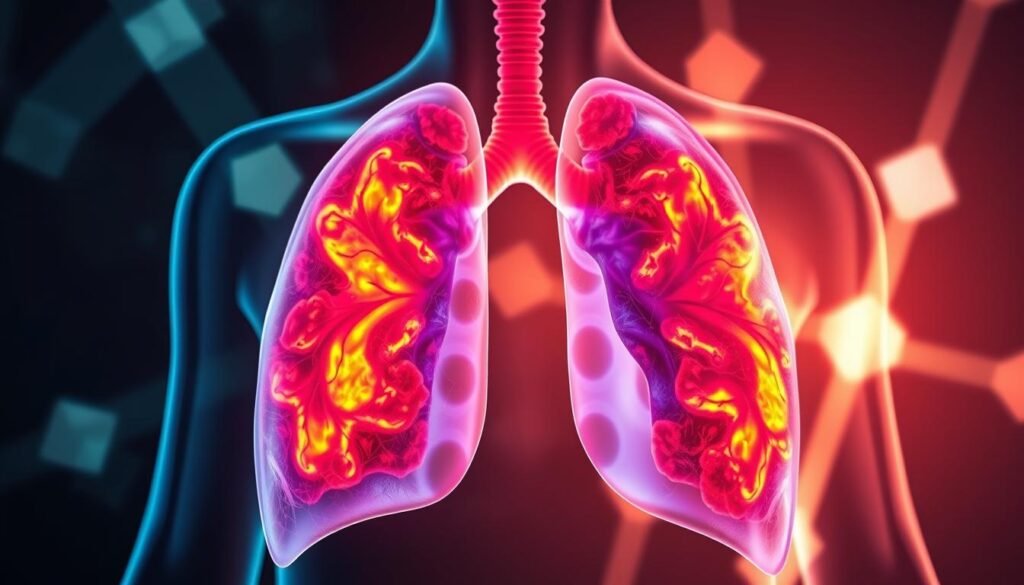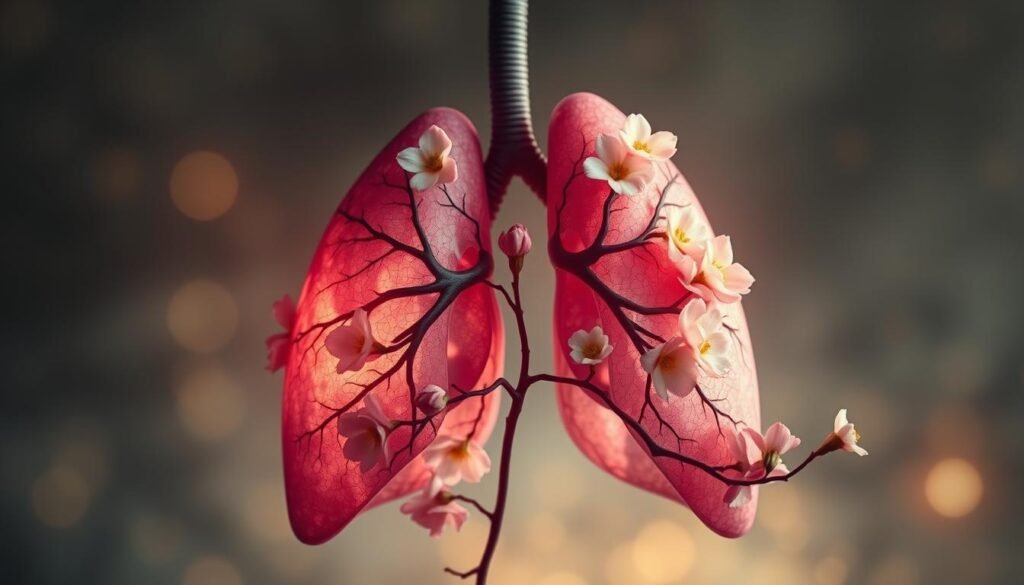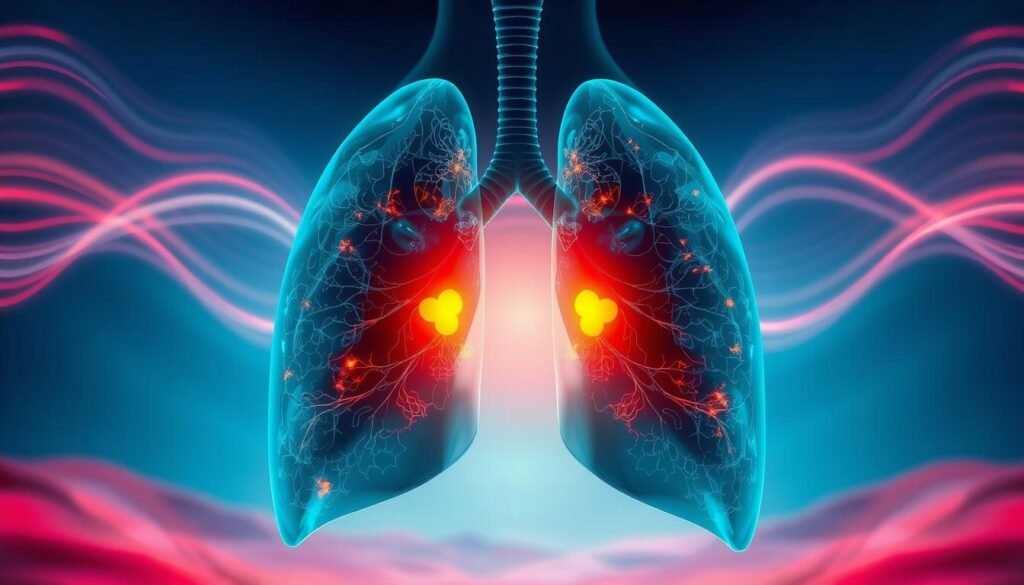Did you know the average mean ipsilateral lung dose from breast cancer radiotherapy is about 9.0 Gy? This fact underlines how breast cancer radiation impacts lung health. It’s a crucial topic that needs focus. While breast cancer radiation greatly helps improve survival rates, it may cause lung issues. This is especially true if the lungs get exposed during treatment. Understanding breast cancer radiation’s impact on the lungs is key. This is vital for those with existing lung problems or risk factors like smoking. Considering treatment techniques and patient positioning differ, it’s important to look into ways to lessen lung damage.
This article will explore the details of breast cancer radiation therapy. We will look at its effects on lung health. This will give valuable information to both patients and healthcare providers.
Key Takeaways
- The average mean ipsilateral lung dose from breast cancer radiotherapy can average around 9.0 Gy.
- Various techniques and positioning during therapy can affect lung exposure levels.
- Individuals with pre-existing lung conditions are at greater risk from radiation effects.
- Smoking significantly increases the risk of radiation-related lung injuries.
- Mitigation strategies can help reduce lung damage during breast cancer radiation therapy.
Understanding Breast Cancer Radiation Therapy
Breast cancer radiation therapy targets and kills cancer cells in affected areas. It uses different cancer radiation techniques, like whole breast radiation and targeted methods. These approaches aim to give the right dose of radiation while protecting healthy tissue.
Research shows how the technique used matters a lot. Factors like the patient’s position and breathing strategies during treatment can affect radiation exposure. Women who get radiation therapy face a higher risk of lung cancer compared to those who don’t. For example, studies found a hazard ratio of 1.59 for lung cancer in women treated with radiation. Knowing these effects helps in making informed treatment decisions.
After 20 years, the rate of lung cancer was 3.0% in women who had radiation therapy, versus 2.3% in those without it. The risk of lung cancer on the same side as the breast treated was much higher. This highlights the need for radiation therapy plans tailored to each patient’s specific needs.
Technology is moving towards lung-sparing radiation therapies. These aim to reduce damage to vital organs while effectively killing the tumor. Such innovations in breast cancer treatment offer hope. They aim to improve patient outcomes and reduce long-term health risks from radiation.
How Breast Cancer Radiation Can Affect the Lungs
It’s key to know how breast cancer radiation impacts the lungs for those getting treatment. This therapy may harm lung function. This happens mostly by accident. Treatments usually expose the lungs to about 9.0 Gy. This exposure can have long-lasting effects.
Radiation Exposure to the Lungs
Radiation can cause issues for the lungs both now and later. Often, problems start six to twelve weeks after treatment ends. If you’re short of breath, have a dry cough, or feel discomfort, it could mean trouble. About 28% of patients get radiation pneumonitis after radiotherapy.
Incidental Lung Damage Risks
Accidental lung damage is a big concern with breast cancer radiation. More radiation means more risk. Radiation lung fibrosis might show up soon or even ten years later. This can turn into a condition with muscle weakness and painful joints. Knowing about and treating lung damage early is important.
| Complication | Symptoms | Potential Treatments |
|---|---|---|
| Radiation Pneumonitis | Shortness of breath, dry cough | Medications, oxygen therapy |
| Radiation-Induced Fibrosis | Muscle weakness, pain, joint aches | Pentoxifylline, topical steroids |
| Radiation Fibrosis Syndrome (RFS) | Muscle pain, neuropathy | Neuropathy medications, surgical options |
Patients should talk with doctors to keep an eye on lung health. This is vital when dealing with radiation therapy effects.
Radiation Therapy Side Effects
People getting radiation therapy for breast cancer might face many side effects. These can really affect their lives. It’s important for these patients and their doctors to know about these side effects. And they need to know how to deal with them.
Common Symptoms Experienced
There are several symptoms that might happen during treatment, including:
- Shortness of breath: This can happen during and after treatment. And it might last a long time.
- Dysphagia: This means having a hard time swallowing because of swelling and soreness.
- Weight loss: This can happen because eating is difficult. And patients might feel sick.
- Fatigue: Feeling very tired is common. It impacts how people feel physically and emotionally.
- Skin reactions: The skin might react but usually gets better 3 to 4 weeks after treatment ends.
- Lymphoedema: This is when fluid builds up in the arm, hand, and breast. It can happen when lymph nodes are affected by radiation.
- Hair loss: Underarm hair might fall out. It can take months to grow back.
Long-term Consequences of Side Effects
While many side effects get better over time, some can last a long time, like:
- Radiation-induced fibrosis: This is when tissue gets hard long after treatment is done.
- Capsular contracture: This is when the shape of a reconstructed breast changes due to treatment.
- Chronic radiation dermatitis: Skin reactions that don’t go away even after therapy is over.
- Bone weakness: Bones in treated areas might break more easily.
- Nerve damage: This can cause tingling, numbness, and even pain or weakness. Sometimes it leads to loss of movement.
- Heart issues: There’s a small risk of heart problems, especially when the left side of the chest is treated.
Pulmonary Complications Associated with Radiotherapy
Radiotherapy can lead to serious lung problems. These include radiation pneumonitis and lung fibrosis. Patients getting treatment for breast cancer need to know about these. Being aware helps find and manage symptoms early. This can make things better for patients.
Pneumonitis and its Implications
Radiation pneumonitis can start soon after treatment. It usually shows up in the first few months. But, symptoms can appear up to a year later. High radiation doses or treating big lung areas raise the risk. Adding chemotherapy or immunotherapy makes lungs more sensitive. This increases the chances of getting this condition.
- Common symptoms of radiation pneumonitis include fever, cough, malaise, shortness of breath, and chest pain.
- Diagnosis may involve a physical exam, chest x-ray, chest CT scan, pulmonary function tests, or bronchoscopy.
- Treatment options range from cough suppressants and bronchodilators to corticosteroids and supplemental oxygen.
- Effective symptom management could include resting, using extra pillows, and dressing in light, loose clothing.
Lung Fibrosis: What You Need to Know
Lung fibrosis is a long-term issue from radiotherapy. It means lung tissue gets thick and scarred. This can slowly harm how lungs work. Lung fibrosis usually starts months or years after therapy ends.
There’s a link between radiation dose and lung fibrosis. So, it’s critical to plan radiation treatments carefully. The condition can be extra hard for those with other lung problems.
| Risk Factor | Impact on Pulmonary Complications |
|---|---|
| High Radiation Dose | Increases likelihood of radiation pneumonitis |
| Concurrent Chemotherapy | Heightens lung sensitivity to radiation |
| Smoker Status | 20% higher risk of developing pneumonitis |
| Existing Lung Conditions (e.g., COPD) | Increasing risk of radiation pneumonitis in lung cancer patients |

Lung Inflammation: Causes and Effects
Lung inflammation can be worrisome for those treated for breast cancer with radiation. It often results from the immune system’s reaction to injured tissues. When trying to mend these areas, the immune system might cause inflammation.
This inflammation is crucially linked to radiation effects, known as radiation pneumonitis. Symptoms can appear 1 to 12 months after treatment, affecting how well the lungs work. High-risk patients include those who received more treatment, had concurrent chemotherapy, larger doses of radiation, or had existing lung issues like COPD.
Age and the tumor’s location also play major roles in the chance of getting lung inflammation. People older than 65 are especially at risk, which highlights the importance of individualized care plans. Because there’s no single test for radiation pneumonitis, doctors must use symptoms, CT scans, and lung function tests to make a diagnosis.
Treatment for lung inflammation can vary widely. Some patients see mild symptoms go away on their own. Others, with serious symptoms, might need medications such as steroids, decongestants, cough suppressants, or bronchodilators. It’s key for patients to tell their doctors about any breathing problems, especially if they’ve had chest radiation within the past year.
Besides breathing issues, lung inflammation can cause other side effects. Problems like difficulty swallowing may require eating softer foods. Also, dealing with pain, heartburn, and nausea is critical for a good life quality.
| Condition | Symptoms | Treatment Options |
|---|---|---|
| Radiation Pneumonitis | Shortness of breath, cough | Steroids, oxygen therapy |
| Difficulty Swallowing | Challenges with solid foods | Diet modifications |
| Overall Health Impact | Weight loss, nausea | Dietitian consultation, anti-sickness medication |
In summary, knowing about lung inflammation caused by radiation therapy is crucial. Early action to manage symptoms can help people recovering from breast cancer treatment feel better and heal faster.
Respiratory Issues Following Breast Cancer Treatment
Many people face breathing problems after breast cancer treatment. This could be ongoing coughs, breathing trouble, or other issues. It’s key to spot these early. Doing so helps in identifying breathing difficulties quickly and getting the right help.
Identifying Breathing Difficulties
Here are some symptoms to watch out for:
- Persistent cough
- Shortness of breath or dyspnea
- Chest pain when breathing deeply
- Getting tired easily during activities
Noticing these symptoms means one can act fast. Regular checks can point out identifying breathing difficulties from chemotherapy or radiation side effects.
Managing Respiratory Symptoms
There are good ways to manage respiratory symptoms and improve life quality. Some methods include:
- Proper medication from doctors
- Custom pulmonary rehab programs
- Regular checks for lung health
- Using extra oxygen if needed
Also, staying hydrated, light exercise, and a good diet help with lung health. By managing these factors well, one can lessen treatment’s effects on lung function.

Cancer Treatment Risks for Smokers
Smokers who face breast cancer treatment face serious risks, especially for lung health. They are more likely to get radiation-induced lung cancer. This is due to existing lung issues that can make treatment side effects worse.
Research shows that smokers have a 2% to 6% increased risk of lung cancer from radiotherapy. Non-smokers have a risk of less than 1%. This highlights the added dangers for smokers.
About 56,400 new breast cancer cases are diagnosed in the UK each year. It’s the most common cancer there. Most of these patients, about 2 in 3, will undergo radiotherapy. Radiotherapy is crucial for stopping cancer from coming back, but it poses specific risks for smokers.
Although only 14% of women in the UK smoke, many keep smoking after a cancer diagnosis. The Labour party promises to provide smoking cessation services for hospitalized patients. This could greatly reduce risks for smokers during treatment.
Long-term smokers in particular should know that smoking increases their treatment risks. It raises the chance of getting lung cancer from treatment. Careful attention to lung health and quitting smoking can greatly lower these risks. Stopping smoking has big benefits, reducing complications and improving treatment success.
Radiation-Induced Lung Injury Explained
Radiation-induced lung injury (RILI) is important for people treated for breast cancer. Found in 1898, it includes harmful effects on the lungs due to chest radiotherapy. Two main injuries are radiation pneumonitis and fibrosis, identified in 1925. These affect patients treated for lung, esophageal, and blood cancers. So, it’s vital to know about lung injury causes during treatment.
The cause of RILI is direct damage to the lungs. This can limit the dose in chest radiotherapy. The chance of getting RILI depends on multiple factors. These include the lung cells’ response to radiation. This makes it hard to diagnose, especially with other present conditions like cancer or infections.
At first, people might not notice RILI symptoms. But they can develop a troubling cough, feel out of breath doing everyday tasks, and feel tired. Scarring from fibrosis can harm lung function permanently. It can make the lungs stiff and lower the oxygen level in the blood, which makes health problems worse.
Up to 30% of patients in some clinical settings may get RILI. Early and effective treatment is key for a better life and prognosis. Treatments such as glucocorticoids and pulmonary rehab can help many patients. RILI is a big challenge, showing the need to watch patients closely during and after breast cancer treatment.

| Type of Lung Injury | Symptoms | Treatment Options |
|---|---|---|
| Radiation Pneumonitis | Cough, breathlessness, fatigue | Glucocorticoids, pulmonary rehabilitation |
| Radiation Fibrosis | Stiff, shrinking lungs, chronic cough | Supplemental oxygen, disease monitoring |
Strategies to Minimize Lung Damage
Managing breast cancer radiation therapy well means using ways to keep lung damage low. Knowing how to do this can really help patients feel better and get better results. One key is learning how to breathe right and how to be positioned correctly during treatment.
Breathing Adaptation Techniques
Changing how you breathe can cut down how much radiation hits your lungs. Research shows the average radiation dose is 9.0 Gy, but it can change with different methods. Using special breathing techniques can drop lung radiation by 1 Gy for full breast treatment. This shows how changing your breathing can protect your lungs.
Patient Positioning During Treatment
How a patient lies during treatment is just as critical. Studies show that lying in certain ways can affect radiation doses. For example, radiation doses are lower, around 1.2 Gy and 0.8 Gy, if patients lie on their stomach or side. But lying on their back for IMRT treatment increases the dose to 9.4 Gy. Using these positions can really help save lungs during therapy.
Adding these careful steps can make a big difference in cancer patients’ lives. It’s important to talk about these techniques with doctors before treatment starts. This ensures care that fits you best and helps you recover well. For more tips on handling symptoms and getting through recovery, check secondary breast cancer treatment and recovery from pneumonectomy.
Conclusion
In summary, it’s very important to know how breast cancer treatments can affect lung health. Treatments like radiation can lead to conditions such as pneumonitis and lung fibrosis. So, knowing the possible side effects is key for patients. The EORTC 22881-10882 study found a significant rate of fibrosis after radiation. This shows why it’s critical to manage these risks carefully.
Keeping an eye on patients after their treatment and clear talk between them and their healthcare teams is vital. If patients spot any breathing issues early, they can get help right away. This can greatly improve their health later on. Websites with information, like guidelines for recognizing warning signs, help patients protect their lung health during this tough time.
Researching more and updating how doctors treat patients is key to reducing bad side effects of radiation. The take-away on radiation’s effects is this: although cancer treatment is hard, knowing what to watch for and talking openly can lead to better lung health and overall well-being.